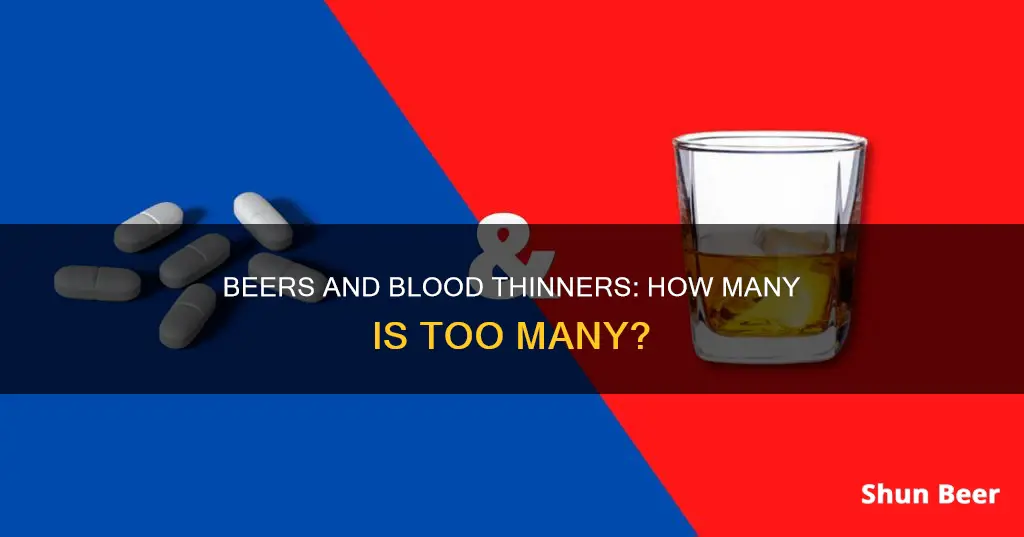
Xarelto (rivaroxaban) is a prescription blood thinner used to prevent blood clots and heart dysrhythmia. It is marketed as a simple and convenient drug with no required dietary changes. However, the combination of Xarelto and alcohol can be dangerous and even life-threatening. Both substances thin the blood and can cause bleeding problems, with alcohol further impairing the liver's ability to process the drug. While occasional drinking may not pose a significant risk, excessive alcohol consumption can lead to severe bleeding, liver damage, and an increased risk of falls and accidents. It is generally advised to avoid alcohol while taking Xarelto, but light to moderate drinking may be permissible under medical supervision. So, how many beers can you drink on Xarelto? The general guideline is no more than one drink per day for women and two drinks per day for men.
| Characteristics | Values |
|---|---|
| Alcoholic drinks that can be consumed with Xarelto | Beer, wine, whiskey, vodka, brandy |
| Recommended number of drinks | 1 drink per day for women, 2 drinks per day for men |
| Excessive drinking | More than 2 drinks per day |
| Side effects | Minor bleeding (nosebleeds, bruising, bleeding gums), major bleeding (menstrual bleeding, coughing up blood, severe headaches), internal bleeding, stroke, fall or injury |
| Risks | Uncontrollable bleeding, liver damage, insomnia, anxiety, depression |
What You'll Learn
- Xarelto and alcohol both thin the blood, increasing the risk of bleeding
- Excessive drinking with Xarelto may cause liver damage
- Alcohol can limit the liver's ability to metabolise Xarelto
- Drinking alcohol with Xarelto may increase the risk of falls and accidents
- Alcohol may intensify the anticoagulant activity of Xarelto

Xarelto and alcohol both thin the blood, increasing the risk of bleeding
Xarelto is a prescription blood thinner used to treat and prevent blood clots. It works by blocking Factor Xa, a critical component of the blood coagulation cascade. This stops blood clots from forming and getting larger.
Alcohol also has a similar effect on the blood. Clinical studies have shown that alcohol can thin the blood by reducing levels of fibrinogen, a protein involved in blood clotting. Research has found that consuming two to three alcoholic drinks per day reduced fibrinogen levels by 14%.
Since both Xarelto and alcohol thin the blood, consuming alcohol while taking Xarelto can increase the risk of bleeding problems. This is because they can dangerously enhance each other's effects. While drinking alcohol in moderation is unlikely to cause significant harm when taking Xarelto, it can still increase the risk of bleeding. This risk is higher for those who drink excessively or chronically.
The side effects of combining Xarelto and alcohol include minor bleeding, such as nosebleeds, bruising, and bleeding gums. However, more severe bleeding events can also occur, such as heavier-than-normal menstrual bleeding, coughing up blood, and severe headaches. Internal bleeding is particularly dangerous as it is challenging to detect and can be life-threatening.
It is important to note that there is no approved antidote to stop the bleeding caused by Xarelto. Therefore, even a relatively minor bleeding incident can become dangerous if left untreated. Additionally, alcohol can increase the risk of falls, trauma, and accidents, which further elevate the risk of harmful uncontrolled bleeding.
While the official recommendation from the manufacturer is that patients do not need to change their dietary habits while taking Xarelto, healthcare professionals generally advise against consuming alcohol with this medication. Experts recommend limiting alcohol consumption to no more than one drink per day for women and no more than two drinks per day for men when taking Xarelto. It is always best to consult with a doctor to understand your specific bleeding risks and make informed decisions about alcohol consumption while taking Xarelto.
Beer and Covid Shots: What You Should Know
You may want to see also

Excessive drinking with Xarelto may cause liver damage
Xarelto (rivaroxaban) is a prescription blood-thinning medication used to prevent blood clots from forming inside the heart and blood vessels. It is processed by the liver and can cause damage to the organ in rare cases. While occasional drinking is usually considered harmless, excessive alcohol consumption can damage the liver over time.
Xarelto and alcohol are both broken down by the liver, and both have a blood-thinning effect. When taken together, they can dangerously enhance each other's blood-thinning effects, increasing the risk of severe bleeding. Excessive drinking while on Xarelto can therefore lead to an increased risk of liver damage and bleeding problems.
The liver is heavily involved in the blood-clotting process, producing most of the proteins needed for blood clots. Excessive alcohol consumption can damage the liver and lead to problems with blood clotting. Adding to this the potential effects of Xarelto on the liver, this combination may cause an increased risk of liver damage and bleeding.
Chronic alcohol use can increase the risk of alcohol use disorder, which is associated with anxiety and depressive disorders. People taking Xarelto who are prone to experiencing anxiety or depression may want to avoid drinking excessively.
If you are taking Xarelto, it is important to speak to your doctor about your risk of bleeding and how much alcohol, if any, is safe for you to consume.
Drinking Dark Beer While Breastfeeding: What You Need to Know
You may want to see also

Alcohol can limit the liver's ability to metabolise Xarelto
Xarelto (generic name: rivaroxaban) is a prescription blood thinner that can be used to prevent blood clots and heart dysrhythmia. It is also used to prevent strokes, pulmonary embolism, and deep vein thrombosis (DVT). When taken, Xarelto blocks factor Xa, a critical component of the blood coagulation cascade.
Alcohol is a substance that can affect the blood-clotting process. It reduces fibrinogen levels, a protein involved in blood clotting, and thins the blood. When combined with Xarelto, alcohol can increase the risk of bleeding problems as both substances have a similar effect on the blood.
The liver breaks down both Xarelto and alcohol. However, the liver may prioritise breaking down alcohol, leading to excess amounts of Xarelto in the bloodstream, which increases the risk of bleeding. This is especially true for regular drinkers, who may need to monitor their blood levels when taking Xarelto.
Chronic alcohol use can also lead to liver damage and altered liver function. If a person has chronic liver problems, the metabolism of Xarelto will be affected. This can result in an increased risk of life-threatening bleeding complications as the blood becomes too thin.
Therefore, it is generally advised to avoid alcohol while taking Xarelto. Light to moderate drinking might be permissible under a doctor's guidance, but it is important to understand the risks involved.
Drinking Beer in Your Car: Driveway Legalities Explained
You may want to see also

Drinking alcohol with Xarelto may increase the risk of falls and accidents
Drinking alcohol while taking Xarelto can be dangerous, and it is recommended that you consult a doctor about your risk of bleeding beforehand. This is because both Xarelto and alcohol thin the blood, which can dangerously enhance each other's effects. Alcohol consumption can also increase the risk of falls, trauma, and accidents, which could be fatal as the anticoagulant effects of Xarelto cannot be reversed. Even a minor bleeding accident can be harmful or even fatal for someone taking Xarelto.
Xarelto is a prescription blood thinner used to treat and prevent blood clots. It is also known by its generic name, rivaroxaban, and is one of the best-selling blood thinners on the market. People who take Xarelto are at risk of severe, uncontrollable bleeding, and there is currently no approved antidote to stop the bleeding. Alcohol also acts as a blood thinner and can interfere with the blood's ability to clot. Research has shown that alcohol can reduce fibrinogen levels, another protein involved in blood clotting. A study found that consuming two to three alcoholic drinks per day reduced fibrinogen levels by 14%.
When combined, Xarelto and alcohol can cause minor to major bleeding problems. Minor bleeding may include nosebleeds, bruising, and bleeding gums. More severe bleeding events can also occur, such as heavier-than-normal menstrual bleeding, coughing up blood, and severe headaches. The most dangerous form of bleeding is internal bleeding, as it is more difficult to detect and can be life-threatening. Alcohol consumption can also increase the risk of falls, accidents, and trauma, which can be deadly for someone taking Xarelto due to the increased risk of uncontrollable bleeding.
It is important to note that the liver breaks down both Xarelto and alcohol, but not necessarily at the same time. When you consume alcohol, the liver may prioritise breaking it down over processing Xarelto, leading to excess amounts of Xarelto in the bloodstream and increasing the risk of bleeding. Additionally, chronic alcohol use can lead to altered liver and kidney function, further impairing the metabolism of Xarelto and increasing the risk of life-threatening bleeding events.
While occasional drinking with Xarelto does not appear to pose a significant risk, excessive alcohol consumption (binge drinking) can result in extreme blood-thinning due to the combined effect. According to the U.S. Dietary Guidelines, moderate drinking is defined as up to one drink per day for women and up to two drinks per day for men. It is important to stay within these limits and not drink for more than a couple of days in a row to avoid heavy alcohol use, which can increase the risk of severe bleeding problems with Xarelto.
Sugar-Free Diets: Beer-Friendly or Foe?
You may want to see also

Alcohol may intensify the anticoagulant activity of Xarelto
Xarelto (generic name rivaroxaban) is a prescription drug used to prevent and treat certain kinds of blood clots in adults and some children. It is a blood thinner, or anticoagulant, that works by blocking factor Xa, a critical component of the blood coagulation cascade.
Alcohol is a substance that can affect the blood-clotting process. It can thin the blood by reducing levels of fibrinogen, a protein involved in blood clotting. One study found that high levels of alcohol consumption, or around two to three drinks per day, reduced fibrinogen levels by 14%.
Since both Xarelto and alcohol thin the blood, consuming alcohol during Xarelto treatment could increase the risk of bleeding. This is because the anticoagulant activity of Xarelto may be intensified by alcohol, which interferes with the blood's ability to clot. Even a couple of beers or a glass of wine may represent a risk for patients taking Xarelto.
The combination of Xarelto and alcohol can be dangerous as there is no approved antidote to stop the bleeding caused by Xarelto. Excessive alcohol consumption can also damage the liver over time, which can lead to problems with blood clotting. Therefore, it is generally advised to avoid alcohol while taking Xarelto. However, light to moderate drinking might be permissible under a doctor's guidance.
If you are taking Xarelto, it is important to talk to your doctor about your specific bleeding risks and how much alcohol is safe to consume.
The Kwak Beer Drinking Ritual: A Step-by-Step Guide
You may want to see also
Frequently asked questions
It is not recommended to drink beer when taking Xarelto, a prescription blood thinner, due to the risk of bleeding. However, occasional drinking with Xarelto is not considered high risk and moderate drinking (1 drink per day for women and 2 drinks per day for men) may be permissible with a doctor's consultation.
It is generally advised to avoid mixing Xarelto and alcohol as both substances thin the blood and can cause dangerous bleeding problems when combined. While light to moderate drinking may be allowed under medical supervision, it is important to consult a doctor to understand your specific bleeding risks.
The side effects of mixing Xarelto and alcohol include an increased risk of bleeding, such as frequent nosebleeds, prolonged bleeding from cuts, and internal bleeding. Alcohol can also impair motor skills, increasing the risk of falls, trauma, and accidents, which can be life-threatening when combined with Xarelto's anticoagulant effects.
Xarelto and alcohol are both broken down by the liver, but not at the same time. When alcohol is present, the liver may prioritize breaking it down, leading to excess Xarelto in the bloodstream and a higher risk of bleeding. Additionally, chronic alcohol use can cause liver damage, further impacting the metabolism of Xarelto and increasing bleeding risks.
Other blood thinners, such as warfarin, are more strongly affected by alcohol consumption. However, it is important to note that combining any blood thinner with alcohol can increase the risk of bleeding. It is always advisable to consult a healthcare professional before mixing medication and alcohol.







